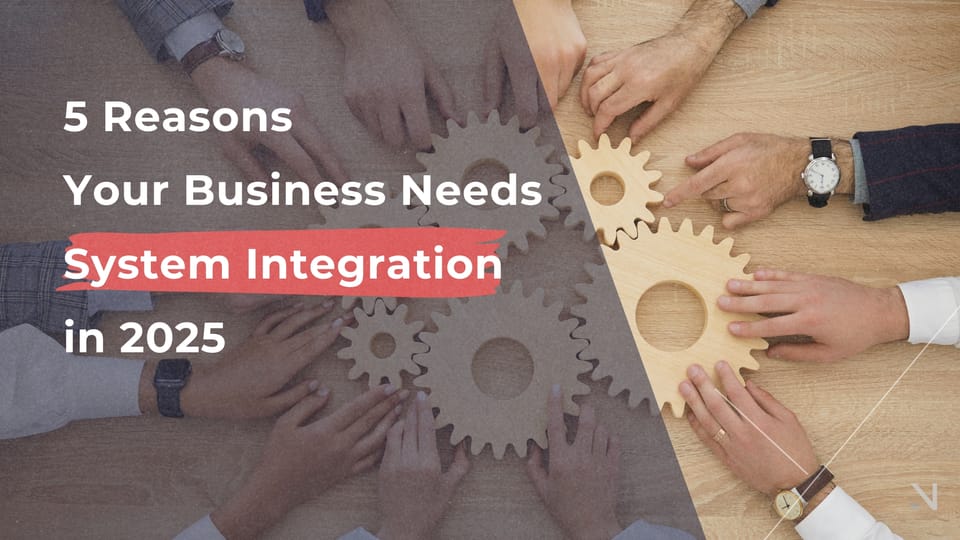5 Reasons Your Business Needs System Integration in 2025
Narima Digital •

In today’s fast-paced digital landscape, businesses rely on multiple tools and software systems to manage operations, enhance customer experiences, and drive growth. However, disconnected systems often lead to inefficiencies, errors, and missed opportunities. System integration—the process of unifying different software and applications into a cohesive ecosystem—has become a game-changer for businesses aiming to stay competitive in 2025.
In this article, we’ll explore five compelling reasons why your business needs system integration, supported by real-world examples to demonstrate its benefits.
What is System Integration?
System integration connects separate software, applications, and data streams into one seamless network. It ensures smooth communication between different systems, allowing data to flow freely and processes to run efficiently. This integration can involve ERP systems, CRM platforms, accounting tools, marketing software, and even IoT devices, depending on the business’s needs.
1. Boost Operational Efficiency
Disjointed systems often mean manual data transfers, duplicated tasks, and inefficient workflows. System integration eliminates these bottlenecks by automating processes and enabling real-time data sharing across departments.

Example:
A retail business with separate inventory, sales, and accounting software often struggles with inventory mismatches and delayed reporting. By integrating these systems, sales data automatically updates inventory levels, while accounting receives accurate transaction records in real time. This saves time and ensures smooth operations.
Key Benefits:
- Faster decision-making with access to real-time data.
- Reduced time spent on manual tasks.
- Improved collaboration between teams.
2. Improve Data Accuracy and Consistency
When systems operate in silos, data discrepancies become inevitable. These errors can lead to costly mistakes, such as incorrect financial reporting or poor customer service. Integration ensures that all systems work from a single source of truth, keeping your data accurate and consistent.

Example:
A logistics company manually transferring customer data between CRM and delivery systems risks entering incorrect addresses, leading to delivery delays. System integration ensures the address entered in the CRM is automatically shared with the delivery system, minimizing errors.
Key Benefits:
- Reliable data for analytics and reporting.
- Enhanced trust in data across the organization.
- Fewer errors in customer interactions and decision-making.
3. Reduce Costs
System integration may require an initial investment, but the long-term cost savings are significant. By automating repetitive tasks, reducing errors, and minimizing the need for multiple software licenses, businesses can achieve substantial financial benefits.

Example:
A manufacturing company using separate systems for production planning, inventory, and HR spends heavily on software licenses and manual data management. Integrating these systems reduces software redundancy and administrative overhead, cutting costs while improving operational visibility.
Key Benefits:
- Lower IT and administrative expenses.
- Reduced need for manual interventions and corrections.
- Maximized ROI from existing tools and systems.
4. Enhance Customer Experience
Today’s customers expect seamless and personalized experiences. Integrated systems allow businesses to provide faster service, more accurate information, and tailored solutions by ensuring all customer-facing systems are synchronized.

Example:
An e-commerce company integrates its website, CRM, and order management systems. When a customer updates their shipping details on the website, the CRM and order systems automatically reflect the changes. This ensures a hassle-free purchasing experience and builds customer loyalty.
Key Benefits:
- Faster response times to customer inquiries.
- Personalized services based on unified customer data.
- Improved brand reputation through consistent service quality.
5. Scale Your Business with Ease
As businesses grow, managing disconnected systems becomes increasingly difficult. Integrated systems provide the scalability needed to handle increased workloads, expand operations, and adopt new technologies without disruptions.

Example:
A fintech startup experiencing rapid growth integrates its core banking software, mobile app, and customer service platforms. This integration supports a growing user base, ensuring smooth functionality and consistent service as the company scales.
Key Benefits:
- Simplified adoption of new tools and technologies.
- Easier onboarding of new team members and departments.
- Future-proof infrastructure for business expansion.
How to Integrate Business Systems Effectively
Successful system integration requires careful planning and execution. Here are some steps to consider:
- Assess Your Needs: Identify pain points in your current systems and prioritize areas for improvement.
- Choose the Right Tools: Work with experts to select integration solutions tailored to your business requirements.
- Partner with Professionals: Collaborate with experienced system integrators like Narima Digital Inovasi to ensure a smooth implementation.
- Test and Optimize: Conduct thorough testing to resolve any compatibility issues and fine-tune processes for maximum efficiency.
In 2025, system integration is not just a luxury but a necessity for businesses aiming to stay competitive in an increasingly digital world. By streamlining operations, improving data accuracy, and enhancing customer experiences, integration empowers businesses to achieve their goals more effectively.
At Narima, we specialize in providing tailored system integration solutions to meet the unique needs of businesses. Let us help you unlock the full potential of your technology stack and drive growth in 2025 and beyond.


